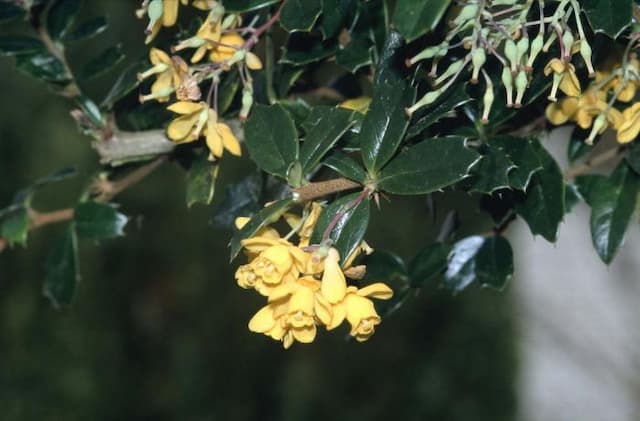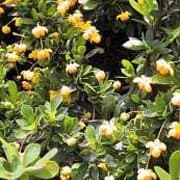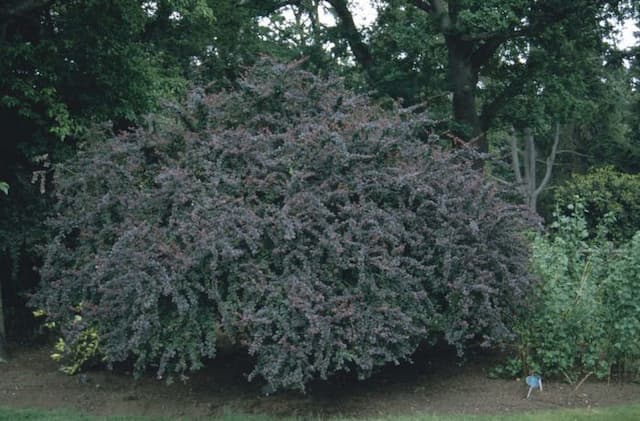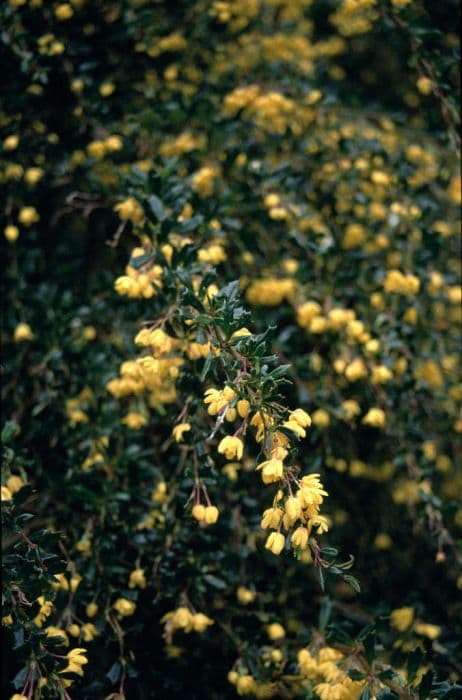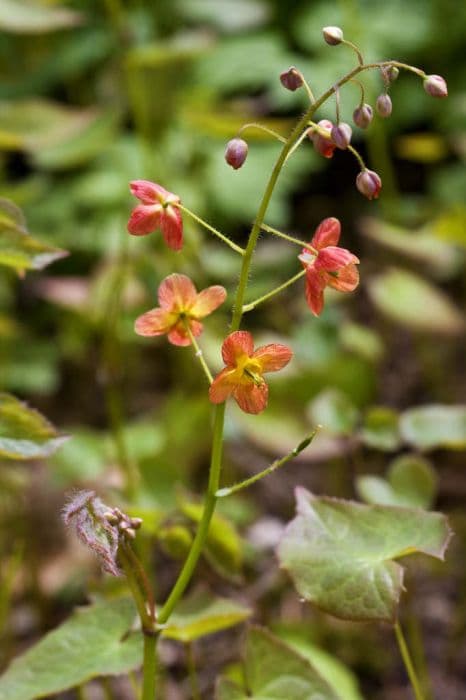Japanese Barberry Berberis thunbergii 'Aurea'

ABOUT
Berberis thunbergii 'Aurea', commonly known as the golden Japanese barberry, is a visually striking shrub known for its vibrant foliage and distinctive form. This deciduous shrub features small, oval-shaped leaves that are a bright, golden-yellow color, which can add a splash of sunlight to any landscape. The leaves are arranged in an alternating pattern along the thorny stems, which adds texture and interest to the plant's overall appearance. In the spring, tiny yellow flowers emerge, adding a subtle contrast to the golden foliage. These blossoms are followed by small, bright red berries that often persist into the winter, providing visual appeal even in the colder months. The berries are also a food source for local wildlife, including birds. The overall shape of the golden Japanese barberry is compact and rounded, with branches that may arch gracefully or remain fairly erect, contributing to the plant's neat, manicured look. The combination of its golden foliage, thorny stems, delicate flowers, and red berries makes it a popular choice for gardeners looking to add year-round interest to their landscape design. In various seasons, the golden leaves may take on different hues, providing a dynamic color display that evolves throughout the year. During autumn, the leaves can develop warm undertones before they eventually drop, revealing the plant's intricate branch structure in winter. This seasonal progression of color and form makes the golden Japanese barberry a dynamic addition to gardens and landscapes where a compact, ornamental shrub is desired.
About this plant
 Names
NamesFamily
Berberidaceae.
Synonyms
Japanese Barberry, Thunberg's Barberry, Red Barberry.
Common names
Berberis thunbergii 'Aurea'.
 Toxicity
ToxicityTo humans
Japanese Barberry is not considered highly toxic to humans. However, ingesting parts of the plant, especially the berries, may cause mild upset stomach, nausea, vomiting, or diarrhea in some individuals. It is always advisable to exercise caution and avoid consuming any part of ornamental plants unless they are known to be edible.
To pets
Japanese Barberry is similarly not highly toxic to pets. If pets ingest parts of the plant, they might experience gastrointestinal discomfort, which could manifest as vomiting or diarrhea. As a general precaution, it's best to prevent your pets from chewing on or ingesting parts of this or any ornamental plant.
 Characteristics
CharacteristicsLife cycle
Perennials
Foliage type
Deciduous
Color of leaves
Yellow-green
Flower color
Yellow
Height
2-3 feet (60-90 cm)
Spread
2-3 feet (60-90 cm)
Plant type
Shrub
Hardiness zones
4-7
Native area
Japan
Benefits
 General Benefits
General Benefits- Ornamental Appeal: Adds vibrant yellow foliage to gardens for visual interest.
- Seasonal Interest: Offers year-round interest with changing foliage colors and red berries.
- Drought Tolerance: Once established, tolerates periods of dryness, reducing the need for frequent watering.
- Low Maintenance: Requires minimal care, making it suitable for busy gardeners or those seeking low-effort landscaping.
- Resistance to Pests: Naturally resistant to many pests, reducing the need for chemical interventions.
- Cold Hardy: Can survive in cold climates, making it suitable for a range of hardiness zones.
- Privacy Screen: Dense growth habit makes it effective for creating privacy hedges or borders.
- Wildlife Attraction: Berries provide food for birds, while foliage provides shelter.
- Soil Erosion Control: Its root system helps stabilize soil on slopes or in areas prone to erosion.
- Contrast Planting: The unique golden foliage contrasts well with darker plants, adding depth to garden designs.
 Medical Properties
Medical PropertiesThis plant is not used for medical purposes.
 Air-purifying Qualities
Air-purifying QualitiesThis plant is not specifically known for air purifying qualities.
 Other Uses
Other Uses- Photography: The bright yellow foliage of the Japanese barberry 'Aurea' adds a vibrant contrast in garden photography, especially when capturing the different textures and colors of a landscape.
- Dyeing Fabric: The inner bark of the Japanese barberry can be used to produce a yellow dye that is suitable for fabric and crafting projects.
- Thorny Barrier: Due to its sharp thorns, the Japanese barberry can be planted as a barrier to deter animals and intruders from entering sensitive areas of a garden or property.
- Bonsai Art: Japanese barberry 'Aurea' makes an excellent choice for bonsai projects due to its small leaves, interesting branch structure, and ability to respond well to pruning and shaping.
- Educational Tool: As an invasive species in some areas, it can be used in educational programs to teach about the impact of non-native plants on local ecosystems and biodiversity.
- Winter Garden Interest: Its persistent red berries and striking yellow foliage that lasts into the fall provide color and interest in the garden during the dull winter months.
- Garden Design: Japanese barberry 'Aurea' can be used in garden design to create color contrasts, particularly in themed gardens focusing on foliage rather than flowers.
- Wildlife Shelter: While it's known to be invasive, the thickets formed by the Japanese barberry provide shelter to birds and small wildlife, especially during harsh conditions.
- Crafting: The dense and woody nature of the branches allows for them to be used in making small crafts such as wreaths or as part of rustic decor arrangements.
- Observational Studies: Can be used by botanists and ecologists to observe the interaction of native plant species with invasive species like the Japanese barberry.
Interesting Facts
 Feng Shui
Feng ShuiThe Japanese Barberry is not used in Feng Shui practice.
 Zodiac Sign Compitability
Zodiac Sign CompitabilityThe Japanese Barberry is not used in astrology practice.
 Plant Symbolism
Plant Symbolism- Protection: The spiny nature of Berberis thunbergii 'Aurea', commonly known as Japanese barberry, often represents protection, as it forms a natural barrier against unwelcome animals and trespassers.
- Purification: Some cultures believe that barberry has purifying qualities, making it symbolic for cleansing and warding off negative energies.
- Sharpness: With its sharp thorns, the Japanese barberry can symbolize the idea of sharpness or intelligence, in both a literal and metaphorical sense.
- Adaptability: Given the plant's ability to thrive in various conditions, it can represent adaptability and resilience in the face of challenges.
 Water
WaterThe Japanese barberry 'Aurea' prefers evenly moist soil, so it's important to water it when the top inch of soil feels dry. Typically, it should be watered once a week, but this can vary depending on climate conditions and soil drainage. During hot summer months, it may require more frequent watering, while in cooler weather or overcast conditions, less watering is needed. A general guideline is to provide approximately 1 to 1.5 gallons of water per week, ensuring that the water penetrates deeply into the soil to encourage strong root growth.
 Light
LightJapanese barberry 'Aurea' performs best in full sun to partial shade. Ideal locations are spots where the plant can receive at least 4 to 6 hours of direct sunlight each day. The bright light helps to intensify the foliage color; however, it can tolerate light dappled shade, particularly in regions with very hot summers.
 Temperature
TemperatureJapanese barberry 'Aurea' is a hardy shrub that can tolerate a range of temperatures, withstanding winter lows down to -30°F and summer highs well above 90°F. The ideal growing temperatures are between 60°F and 75°F. These conditions promote healthy growth and vibrant leaf coloration.
 Pruning
PruningPrune Japanese barberry 'Aurea' mainly to maintain its shape and encourage vigorous growth. The best time for pruning is late winter or early spring before new growth begins. It can be pruned annually, removing any dead or diseased branches, and to shape as desired. Be cautious of its thorns when handling the plant.
 Cleaning
CleaningAs needed
 Soil
SoilJapanese barberry 'Aurea' prefers well-drained soil with a pH range of 6.0 to 7.5. A mix of loam, organic compost, and a small amount of sand or perlite will provide the ideal growing conditions. Regular mulching can help maintain soil moisture and health.
 Repotting
RepottingJapanese barberry 'Aurea' does not need frequent repotting; it is usually repotted every 2-3 years. If the plant shows signs of being root-bound or if the soil quality has deteriorated, it is time to repot.
 Humidity & Misting
Humidity & MistingJapanese barberry 'Aurea' is tolerant of a wide range of humidity levels and does not require any special humidity conditions. Average ambient humidity is typically sufficient for this hardy plant.
 Suitable locations
Suitable locationsIndoor
Provide bright light, well-draining soil, and occasional watering.
Outdoor
Plant in full sun to partial shade in well-draining soil.
Hardiness zone
4-8 USDA
 Life cycle
Life cycleBerberis thunbergii 'Aurea', commonly known as Japanese barberry 'Aurea', begins its life as a seed, which, after a period of dormancy, germinates in spring when soil temperatures rise. In its first year, the seedling develops a root system and a small stem with foliage, focusing on establishing itself. As a perennial, the Japanese barberry 'Aurea' then enters a growing phase, where it matures over several years, developing into a dense, compact shrub with yellow leaves that can reach 2 to 4 feet in height and width. It reaches reproductive maturity within a few years, producing small yellow flowers in late spring, which are followed by bright red berries by autumn, the fruits persisting into winter. These berries are then consumed and dispersed by wildlife, allowing seeds to be deposited in new locations where they may germinate and begin the cycle anew. The shrub can live for many years, during which time it may be pruned or shaped to maintain health or desired aesthetics.
 Propogation
PropogationPropogation time
Late Winter to Early Spring
The Japanese barberry 'Aurea' is most commonly propagated by softwood cuttings taken in late spring or early summer. This involves selecting healthy, non-flowering shoots from the current year’s growth. The cuttings should be about 4 to 6 inches (10 to 15 centimeters) long, with the lower leaves removed. The cut end of the cutting can be dipped in a rooting hormone powder to increase the chances of successful rooting. Then, the cuttings are planted in a well-draining rooting medium, such as a mix of peat and perlite, and kept in a humid environment with indirect light until roots develop, which usually takes several weeks. Once rooted, the cuttings can be transplanted into individual pots and eventually into the garden.
